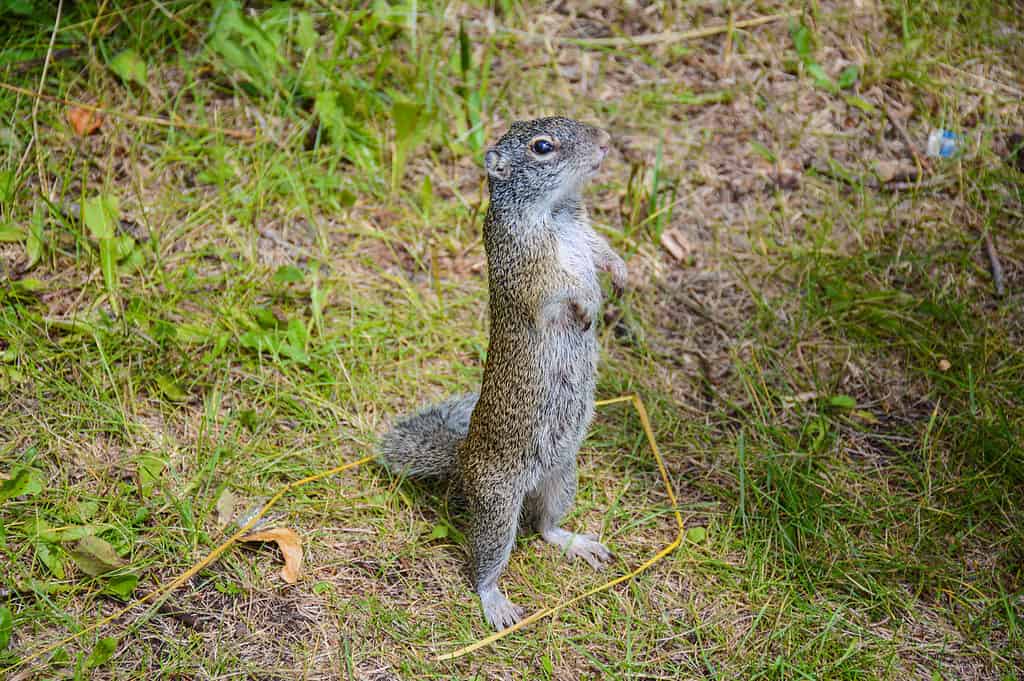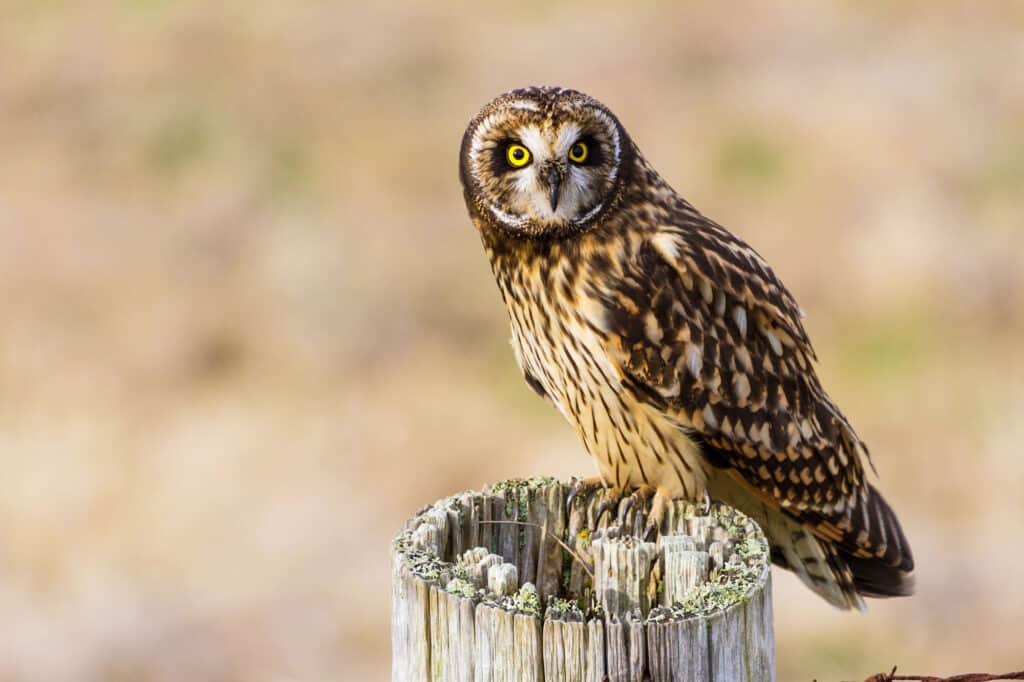There are over 5,000 animal species in North America. Unfortunately, many of them are at risk of extinction. Scientists estimate that up to 90% of mammals and about 99% of birds on earth may be going extinct. These scary statistics are no thanks to centuries of destructive human activities. The state of Illinois, for example, has always been blessed with bountiful wildlife. But in recent times, the midwestern state has seen its share of threatened and endangered animal species. These threats of extinction can be attributed to different factors such as habitat loss, hunting, illegal wildlife trade, and so on. Read on to discover four of the endangered animal species that call Illinois home.
1. Gray Wolf

Due to run-ins with humans and habitat destruction, gray wolves have become endangered in Illinois.
©Bildagentur Zoonar GmbH/Shutterstock.com
Gray wolves (Canis lupus) are distinctive wolf species that were once abundant in several regions of North America, including Illinois. Today, they are considered the largest wild canine in Illinois. Scientists believe that in North America alone, they used to number about two million. Due to run-ins with humans and habitat destruction, gray wolves have become endangered in Illinois.
Since the ’70s, the gray wolf has been listed among the endangered animal species by the US Fish and Wildlife Service. These wolf species are protected under the Illinois Wildlife Code, which was established in 2015. It is illegal to hunt or kill them. Instead, residents are encouraged to contact the Illinois Department of Natural Resources (IDNR) to report wolf threats.
Contrary to what most people believe, gray wolves are not vicious creatures. They play an important role in keeping the ecosystem balanced and healthy. They are mostly responsible for keeping deer and elk populations in check, and their prey carcasses help spread nutrients into the soil. More so, they need land space to travel, hunt, and breed if their species is to survive.
Despite the legal measures to protect them, gray wolves are still very much vulnerable. In the Northern Rockies, over 500 wolves have been killed by humans in the last year alone. Gray wolves have been politically stripped of protection twice, once in 2011 and again in 2020. Many criticized the Trump administration for its impulsive decision to revise the Endangered Species Act in 2020. This decision left the wolves vulnerable and exposed to extinction. A court order in February 2022 reinstated the protection act, excluding certain states. While preservation techniques will go a long way, teaching humans the importance of gray wolves to the ecosystem will help to foster a positive mindset about their crucial status.
2. Franklin’s Ground Squirrel

Due to habitat loss and fragmentation. Franklin’s ground squirrels have become endangered.
©iStock.com/Jeff439
This squirrel (Poliocitellus franklinii) is a diurnal rodent native to North America. It was once abundant but now has a steadily declining population. The Illinois Department of Natural Resources has listed it as an endangered animal in Illinois due to habitat loss and fragmentation. Most regions with tall grasses have been transformed into agricultural or urbanized lands. This has forced the squirrels to migrate out of Illinois because they have been unable to adapt to the change. Habitat loss has also made it difficult for them to get their preferred diet of dandelions and insect eggs.
Since the squirrels are listed as endangered, the Illinois government has declared that the mishandling, capture, or lethal removal of these squirrels by humans is strictly prohibited and illegal. However, the cousin of the Franklin’s ground squirrel, the thirteen-lined ground squirrel (Ictidomys tridecemlineatus), is not under IDNR protection, which permits hunting.
As regards their ecological role, ground squirrels help out in soil aeration. They are partly responsible for conditioning the soil for plant growth, and their body wastes contribute to the organic layout of the soil.
Sometime in 2010, the triple alliance of the Springfield Park District, Sangamon County, and the developers of the Centennial Park Place subdivision in Illinois built earthen ridges to help the squirrels with their burrowing. The partners made a statewide appeal to the inhabitants on the need to curb certain human activities in order not to isolate the species again.
3. Short-Eared Owl

The short-eared owl is vulnerable to diurnal raptors, such as bald eagles, northern goshawks, red-tailed hawks, and snowy owls.
©iStock.com/Devonyu
The short-eared owl (Asio flammeus), also known as the marsh owl or grass owl, is one of the most unique birds in the world. Unfortunately, it is one of the endangered animal species in Illinois. Precisely in 1992, the US Fish and Wildlife Service classified the owl as a migratory nongame bird of management concern. The nearly complete destruction of its grassland and wetland habitats has contributed to the bird becoming largely endangered in Illinois. The owl used to be the most abundant bird species in the state until its habitat loss became a huge problem.
Animal observers regard it as an uncommon migrant and a rare summer resident in Illinois. They play an important ecological role by helping to keep the rodent population in the region under control.
According to the IDNR, the only way to preserve the short-eared owl is to preserve its habitat. By nature, short-eared owls roost, forage, and create nests in inland areas like grasslands and fields. They can be sensitive and uncomfortable when it comes to human activity; therefore, they need as much space as possible away from human development. Habitat loss, the chief reason for endangerment, stems from developmental projects and agricultural use of grasslands and marshes.
Human activity has also led to large-scale prey unavailability for this bird species — a dangerous trend for survival. To ensure the owl’s survival, the Illinois government must establish grassland reserves as management programs and create a clear-cut distinction between human and owl territories.
4. Southern Watersnakes

The southern watersnake has no venom and helps control the rodent population.
©EdwinWilke/Shutterstock.com
Typically, most snake species in Illinois are not endangered because they compete effectively with other animals in their habitat. Their ability to adapt within a wide range of temperatures, subdue prey with venom, reproduce regularly, and dominate the food chain, gives them several advantages. However, we cannot say the same for southern watersnakes (Nerodia fasciata fasciata) in Illinois. This snake species has been on the endangered species list along with 12 other snake species for a long time.
Habitat loss and attacks from humans have widely contributed to the decline in this snake population. A lot of people view snakes as threats and do not consider them beneficial to the ecosystem. This means that most people unapologetically destroy grasslands, swamps, and forests where snakes live. Another factor contributing to their depletion is the reptile trade. The trade is illegal, yet it flourishes because it is profitable. Fear and misinformation among the populace also cause people to kill snakes indiscriminately, causing a dearth in population.
The first step in preserving this snake’s population is proper wildlife education. People need to be educated about the importance of preserving snakes. Unlike most venomous snakes, the southern watersnake has no venom and helps control the rodent population. The government would also need to heighten law enforcement measures if southern watersnakes must survive in Illinois.
Conclusion
In our increasingly developing world, preserving any species is not particularly easy due to never-ending developments and territorial expansions. The truth, however, remains that humans are largely responsible for the extinction and potential extinction of several animal species within the ecosystem. Therefore it is the collective responsibility of governments and the average person to be mindful of their actions towards the environment and to devise strategies that would ensure the long-term sustainability of endangered animal species in Illinois. This would include giving them space to thrive, grow, breed, and move without the usual interference of humans in their existence will go a long way.
Up Next
- 15 Endangered Species in Texas
- The 10 Most Endangered Species On Earth – And How To Help
- 6 Endangered Animals Recently Declared Extinct
The photo featured at the top of this post is © Nagel Photography/Shutterstock.com
Thank you for reading! Have some feedback for us? Contact the AZ Animals editorial team.







